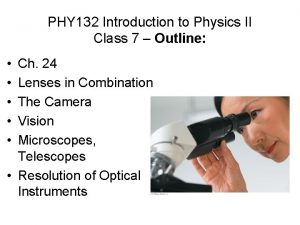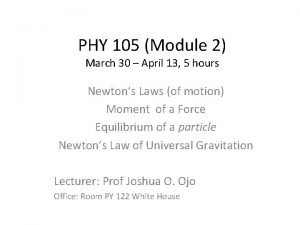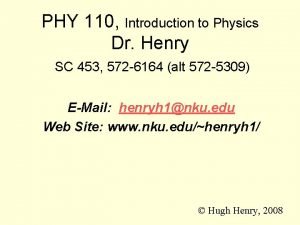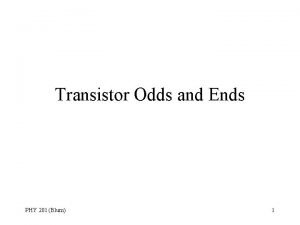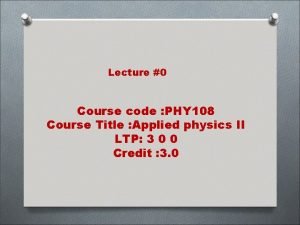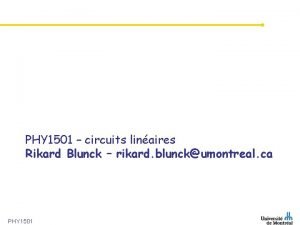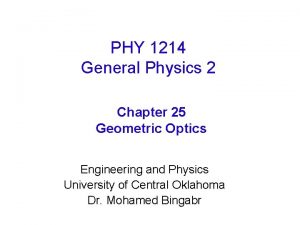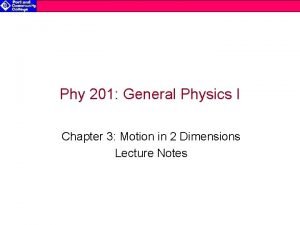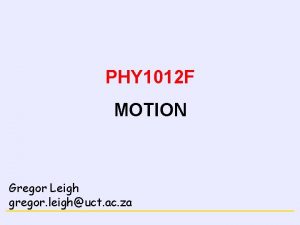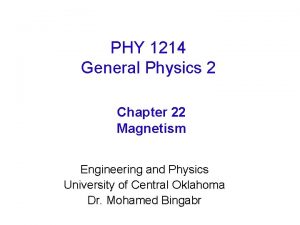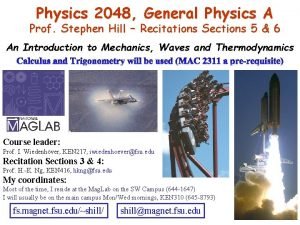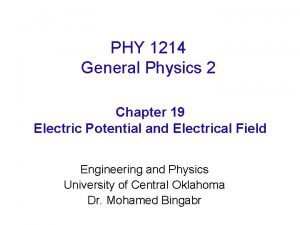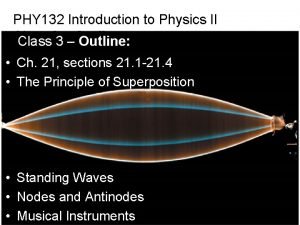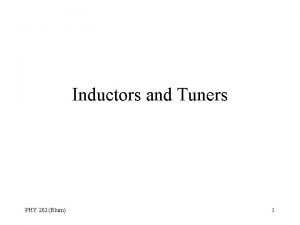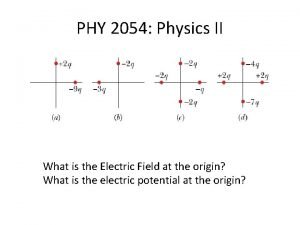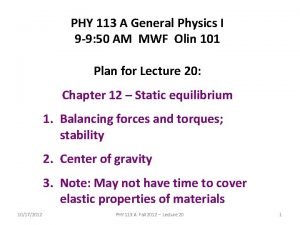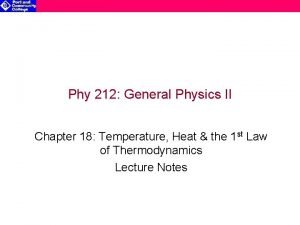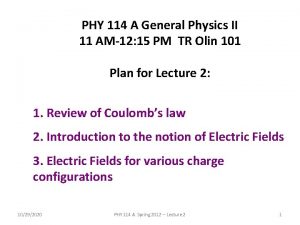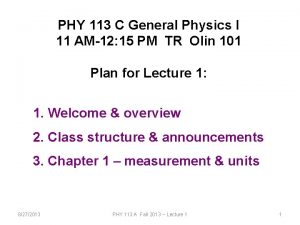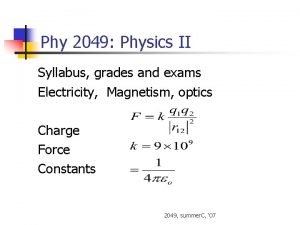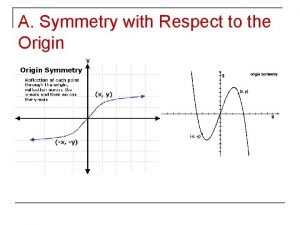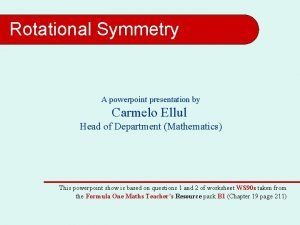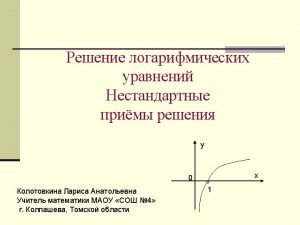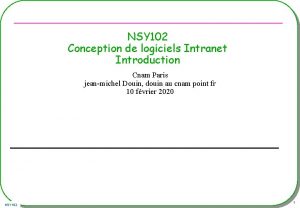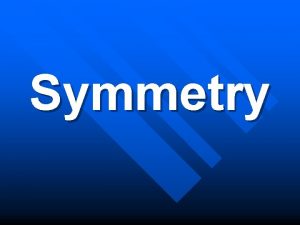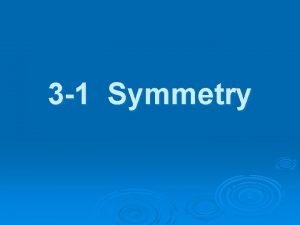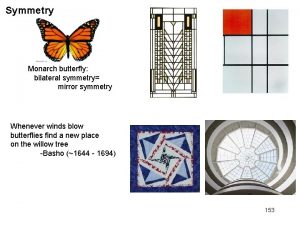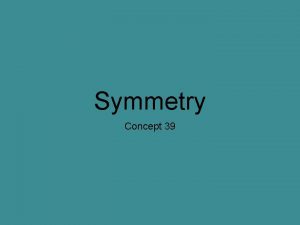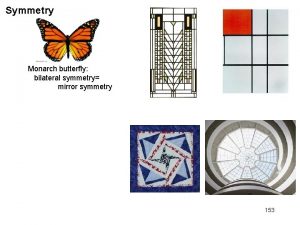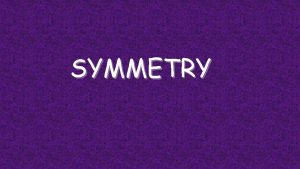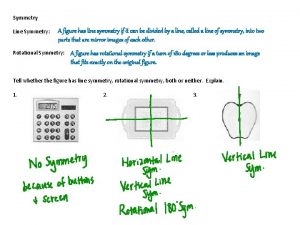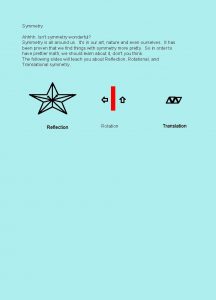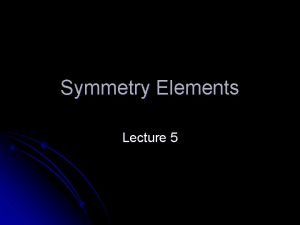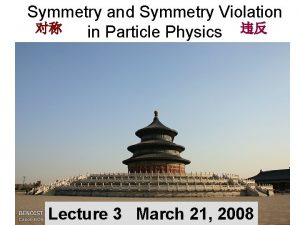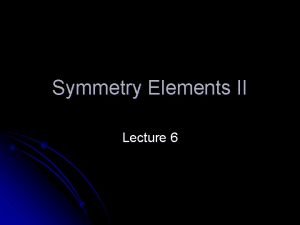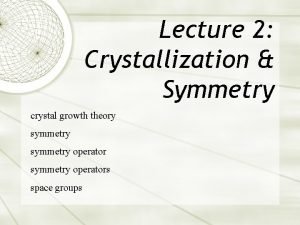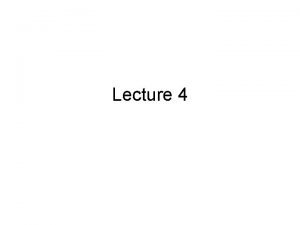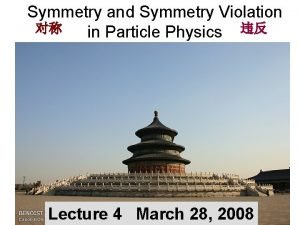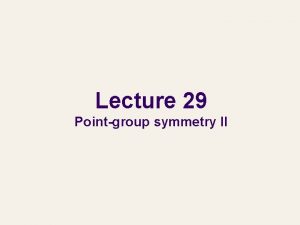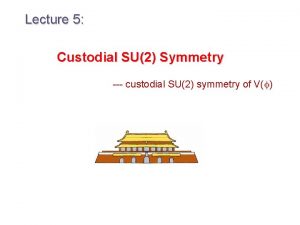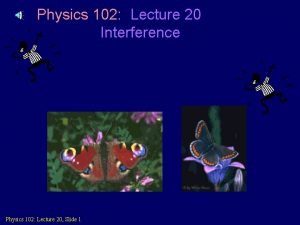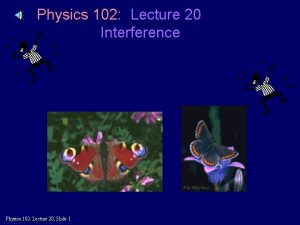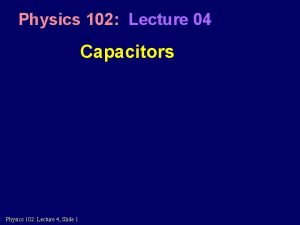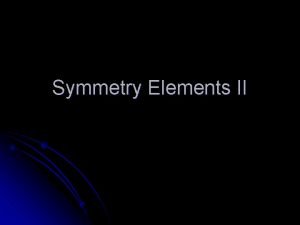PHY 102 Lecture 3 3 1 Symmetry 3











































- Slides: 43

PHY 102: Lecture 3 • • 3. 1 Symmetry 3. 2 Concept of Flux 3. 3 Calculating Electric Flux 3. 4 Gauss’ Law

PHY 102: Lecture 3 Electric Field 3. 1 Symmetry

What Good is Symmetry • Symmetry lets us find the shape of the electric field • Symmetry arguments allow us to rule out many conceivable field shapes as simply being incompatible with the symmetry of the charge distribution • Symmetry does not tell us about the strength (magnitude) of the field or how it changes with distance

Symmetry - 1 • A charge distribution is symmetric if there a group of geometrical transformations that don’t cause any physical change • Suppose you close your eyes while a friend transforms a charge distribution in one of the following three ways ØTranslate (displace) the charge parallel to an axis ØRotate the charge about and axis ØReflect the charge in a mirror

Symmetry - 2 • You open your eyes • You might be able to tell if the charge distribution changed by observing a visual difference • Or results of an experiment with charged particles could reveal that distribution has changed • If nothing you can see or do reveals any change then we say the distribution is symmetric under that particular transformation

Symmetry - 3 A charge distribution that is symmetrical under these three groups of geometrical transformations is said to be cylindrically symmetric Other charge distributions have other types of symmetry

Symmetry - 4 • Interest in symmetry can be summed up in a single statement • The symmetry of the electric field must match the symmetry of the charge distribution

Types of Symmetry The field is radial toward or away from the center

PHY 102: Lecture 3 Electric Field 3. 2 Concept of Flux

Concept of Flux - 1 (a) The field is coming out of each face of the box. There must be a positive charge in the box. • An opaque box surrounds a region of space • We can’t see what’s in the box • Electric field vectors come out of each face of the box • Can we figure out what’s in the box?

Concept of Flux - 2 (a) The field is coming out of each face of the box. There must be a positive charge in the box. • Electric fields point away from positive charges • Electric field comes out of every face of box (a) • It seems clear that the box contains a positive charge or charges • Similarly, box (b) contains a negative charge

Concept of Flux - 3 (a) The field is coming out of each face of the box. There must be a positive charge in the box. • Electric field points into box (c) on the left • An equal electric field points out on the right • This might be the electric field between a large positive somewhere out of sight on the left and a large negative charge off to the right

Gaussian Surface - 1 • Surround a region of space with a closed surface • Surface that divides space into inside and outside regions • A closed surface through which an electric field passes is called a Gaussian surface • This is an imaginary surface, not a physical surface • Figure (a) is a spherical Gaussian surface

Gaussian Surface – 2 • The spherical symmetry of the electric field vectors poking through the surface tells us that the positive charge inside must be spherically symmetric • And centered at the center of the sphere Ø Electric field is everywhere perpendicular to the spherical surface Ø Electric field has the same magnitude at each point on the surface

Gaussian Surface - 3 • • • Another example Electric field emerges from four sides of cube (a) But not from the top or bottom We can’t be sure what charge is inside the box Figure (b) uses a different Gaussian surface, a closed cylinder

Gaussian Surface - 4 • With a better choice of surface, we can tell that the cylindrical Gaussian surface surrounds some kind of cylindrical charge distribution, such as a charged wire Ø Electric field is everywhere perpendicular to the cylindrical surface Ø Electric field has the same magnitude at each point on the surface

Gaussian Surface - 5 • Consider the spherical surface in figure (a) • The protruding electric field tells us there’s a positive charge inside • It might be a point charge located on the left side, but we can’t say • A Gaussian surface that doesn’t match the symmetry of the charge distribution isn’t useful

Gaussian Surface - 6 • The nonclosed surface in figure (b) doesn’t provide much help either • What appears to be a uniform electric field to the right could be due to a large positive charge on the left, a large negative charge on the right, or both • A nonclosed surface doesn’t provide enough information

Gaussian Surface - 7 • The electric field “flows” out of a closed surface surrounding a region of space containing a net positive charge • “Flows” into a closed surface surrounding a region of space containing a net negative charge • The electric field may flow through a closed surface surrounding a region of space in which there is no net charge, but the net flow is zero • The electric field pattern through the surface is particularly simple if the closed surface matches the symmetry of the charge distribution inside • The amount of electric field passing through a surface is called the electric flux

Gaussian Surface - 8 • There is an outward flux through a closed surface around a net positive charge • There is an inward flux through a closed surface around a net negative charge • There is no net flux through a closed surface around a region of space in which there is no net charge

PHY 102: Lecture 3 Electric Field 3. 3 Calculating Electric Flux

Calculating Electric Flux • Figure shows a surface of area A in a uniform electric field E • n is the unit vector perpendicular to the surface • Only the component E = Ecosq passes through the surface

Definition of Electric Flux • Electric Flux is Fe • Measures the amount of electric field passing through a surface of area A • If the perpendicular to the surface is tilted at an angle q from the field • Fe = EAcosq

Example–Parallel Plate Capacitor • Two 0. 01 m 2 parallel plates • One is charged +5 x 10 -9 C, the other is charged -5 x 10 -9 C • A 0. 01 m x 0. 01 m surface between the plates is tilted so its normal makes a 450 angle with the electric field • What is electric flux through the surface? • Fe = EAsurfacecosq = (q/e 0 Aplate)Asurfacecosq • Fe = (5 x 10 -9/8. 85 x 10 -12 x 0. 01)1. 0 x 10 -4 x cos 45 • Fe = 4. 00 Nm 2/C

Example–Cylindrical Charge-1 • Electric field of a cylindrical charge distribution is E = E 0(r 2/r 02) • Calculate the electric flux through a closed cylinder of length L and radius R that is centered along the z-axis • The electric field extends radially outward from the z-axis with cylindrical symmetry • The z-component is Ez = 0 • The cylinder is a Gaussian surface

Example–Cylindrical Charge-2 • Figure (a) is a view of the electric field looking along the zaxis • Field strength increases with increasing radial distance • Field is symmetric around the z-axis • Figure (b) is the closed Gaussian surface for which we need to calculate the electric flux • We can place the cylinder anywhere along the z-axis because extends to infinity in that direction

Example–Cylindrical Charge-3 • To calculate the flux, divide the closed cylinder into three surfaces: the top, the bottom, and the cylindrical wall • The electric field is tangent to the surface at every point on the top and bottom surfaces • For the top and bottom cosq = cos 90 = 0 • The flux through top and bottom surfaces is zero • For the cylindrical wall the electric field is perpendicular to the surface everywhere cosq = cos 0 = 1

Example–Cylindrical Charge-4 • The electric field has constant magnitude E = • • E 0(r 2/r 02) at every point on the cylindrical wall Fe = EAwall Net flux through the closed surface is Fe = Ftop + Fbottom + Fwall = 0 + EAwall = 2 p. RL

Example–Cylindrical Charge-5 Notice the important role played by symmetry The electric field was perpendicular to the wall and of constant value at every point on the wall because the Gaussian surface had the same symmetry as the charge distribution

PHY 102: Lecture 3 Electric Field 3. 4 Gauss’ Law

Purpose of Gauss’ Law • Gauss’ law allows the electric field of some continuous distributions of charge to be found much more easily than does Coulomb’s law

Gaussian Surface – Point Charge - 1 • Figure shows a spherical Gaussian surface of radius r centered on a positive charge q • This is an imaginary surface • There is a net flux through this surface because the electric field points outward at every point on the surface

Gaussian Surface – Point Charge - 2 • The electric field is perpendicular to the surface at every point on the surface • From Coulomb’s law it has the same magnitude E = q/4 pe 0 r 2 at every point on the surface • This simple situation arises because the Gaussian surface has the same symmetry as the electric field

Gaussian Surface – Point Charge - 3 • This is equally valid for a negative charge • In this case the flux is negative because the electric field points inward

Gaussian Surface – Point Charge - 4 • Note that the electric flux depends on the amount of charge but not on the radius of the sphere • The point charge is the only source of electric field • Every electric field line passing through a small radius spherical surface also passes through a largeradius spherical surface • Hence, the electric flux is independent of r

Gaussian Surface – Point Charge - 5 • This is also the flux through any closed surface surrounding a point charge • The net electric flux is zero through a closed surface that does not contain any net charge

Gauss’ Law – Field of Point Charge • Gaussian Surface is a sphere with the charge at the center • Electric field is the same everywhere on the sphere • Electric field is perpendicular to sphere • Electric Flux = EA = q/e 0 • E(4 pr 2) = q/e 0 • E = q/4 pr 2 e 0 = kq/r 2

Gauss’ Law – Field Outside Shell of Charge • Gaussian Surface is a sphere with the shell at the center (outside shell) • Electric field is the same everywhere on the sphere • Electric field is perpendicular to sphere • Electric Flux = EA = q/e 0 • E(4 pr 2) = q/e 0 • E = q/4 pr 2 e 0 = kq/r 2 (r > R) Charge q uniformly spread over spherical shell

Gauss’ Law – Field Inside Shell of Charge • Gaussian Surface is a sphere with the shell at the center (inside shell) • Electric field is the same everywhere on the sphere • Electric field is perpendicular to sphere • Electric Flux = EA = q/e 0 • Charge is 0 inside Gaussian Surface • E(4 pr 2) = 0/e 0 • E = 0 (r < R) Charge q uniformly spread over spherical shell

Gauss’ Law – Field in Parallel Plate Capacitor-1 • Gaussian Surface is a cylinder starting inside one of the plates • Electric field is the same everywhere on the sphere • Electric field is perpendicular to the plates • Surface 1 • Electric Flux = EA = q/e 0 • Field is 0 inside metal plate • Flux = EA = 0

Gauss’ Law – Field in Parallel Plate Capacitor-2 • Gaussian Surface is a cylinder starting inside one of the plates • Electric field is the same everywhere on the sphere • Electric field is perpendicular to the plates • Surface 2 • Electric Flux = EA • Field is parallel to surface • cosf = cos 90 = 0 • Flux = EA = 0

Gauss’ Law – Field in Parallel Plate Capacitor-3 • Gaussian Surface is a cylinder starting inside one of the plates • Electric field is the same everywhere on the sphere • Electric field is perpendicular to the plates • Surface 3 • Electric Flux = EA

Gauss’ Law – Field in Parallel Plate Capacitor-4 • • Electric Flux = EA = q/e 0 Electric Flux = 0 + EA Electric Flux = EA Charge on plate contained within cylinder is q EA = q/e 0 E = (q/A)e 0 charge/area = s = q/A E = s/e 0
 What is farsightedness called
What is farsightedness called 01:640:244 lecture notes - lecture 15: plat, idah, farad
01:640:244 lecture notes - lecture 15: plat, idah, farad General physics measurement
General physics measurement Phy 131 past papers
Phy 131 past papers Phy-105 5 discussion
Phy-105 5 discussion Law of motion
Law of motion Phy
Phy Physics 2
Physics 2 Phy theorem
Phy theorem Phy108
Phy108 Rikard blunck
Rikard blunck Phy 1214
Phy 1214 Phy 205
Phy 205 Vx=vox+axt
Vx=vox+axt Pa msu
Pa msu Complete motion diagram
Complete motion diagram Atm packet phy
Atm packet phy Phy
Phy Phy 113 past questions and answers
Phy 113 past questions and answers Phy tgen
Phy tgen General physics
General physics Loncapa fsu
Loncapa fsu Phy 1214
Phy 1214 Accommodation eye
Accommodation eye Phy 132
Phy 132 The great orthogonality theorem
The great orthogonality theorem Phy
Phy Fizik ii
Fizik ii Phy 131 asu
Phy 131 asu 2012 phy
2012 phy Physics heat and temperature
Physics heat and temperature Phy
Phy Phy 2049
Phy 2049 Phy 1214
Phy 1214 Rotational statics
Rotational statics Life phy
Life phy Phy 2049
Phy 2049 Ddr phy architecture
Ddr phy architecture Origin symmetry graph
Origin symmetry graph Symmetry elements and symmetry operations ppt
Symmetry elements and symmetry operations ppt Nur 102
Nur 102 102 lgx
102 lgx Convenio 102 oit
Convenio 102 oit Jmx 102
Jmx 102
